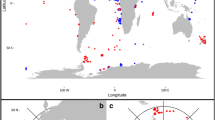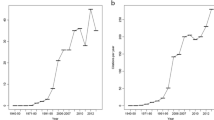Abstract
Although many studies exist which document abundances of epibenthic and sediment-dwelling macrofauna from seagrass habitats, little descriptive or experimental information is available on meiofauna from these systems. Much of this discreapancy is a result of sampling techniques or sample processing. Herein we critically review the literature on meiofauna from temperate and tropical seagrass systems and present data on meiofauna from three subcommunities within a Tampa Bay, Florida seagrass bed—seagrass blades, sediments surrounding individual culms and the water column. Four areas for future research are identified: 1) comparisons of macrofauna and meiofauna from seagrass sites and a description of their trophic interactions; 2) elucidation of relationships between meiofauna and algal epiphytes; 3) monitoring of vertical migration of meiofauna from sediments into the water column; and 4) biogeographic comparisons of 1–3 above.
Similar content being viewed by others
Literature Cited
Alheit, J., andW. Scheibel. 1982. Benthic harpacticoids as a food source for fish.Mar. Biol. 70:141–147.
Alldredge, A. L., andJ. M. King. 1977. Distribution abundance and substrate preferences of demersal reef zooplankton at Lizard Island Lagoon, Great Barrier Reff.Mar. Biol. 41:317–333.
Alldredge, A. L., andJ. M. King. 1980. Effects of moonlight on the vertical migration patterns of demersal zooplankton.J. Exp. Mar. Biol. Ecol. 44: 133–156.
Bell, S. S., andB. C. Coull. 1978. Field evidence that shrimp predation regulates meiofauna.Oecologia (Berl.) 35:141–148.
Bell, S. S., andB. C. Coull. 1979. Experimental evidence for a model of juvenile macrofauna-meiofauna interactions, p. 179–192.In K. R. Tenore and B. C. Coull (eds.), Marine Benthic Dynamics. Univ. of South Carolina Press, Columbia.
Bell, S. S., J. C. Kern, and K. Walters. 1984. Sampling for meiofaunal taxa in seagrass systems: lessons from studies in a subtropical Florida estuary, U.S.A.In Internat. Symp. Shallow Wat. Benthic Invert., Indian Ocean.
Brawley, S. H., andW. D. Adey. 1981. The effect of micrograzers on algal community structure in a coral reef microscosm.Mar. Biol. 61:167–177.
Brook, I. M. 1977. Trophic relationships in a seagrass community (Thalassia testudinum) in Card Sound, Florida. Fish diets in relation to macrobenthic and cryptic faunal abundance.Trans. Am. Fish. Soc. 106:219–229.
Caine, E. A. 1980. Ecology of two littoral species of caprellid amphipods (Crustaecea) from Washington, U.S.A.Mar. Biol. 56:327–335.
Coull, B. C., andS. S. Bell. 1979. Perspectives of marine meiofaunal ecology. p. 189–216.In R. J. Livingston (ed.). Ecological processes in coastal and marine ecosystems. Plenum Press, New York.
Dennis, R. E. 1981. The role of the seagrassSyringodium filiforme and sediment stability on benthic harpacticoid copecods. MSc Thesis, Florida State University, Tallahassee, 27 p.
Gerlach, S. A. 1971. On the importance of marine meiofauna for benthos communities.Oecologia (berl.) 6:176–190.
Greening, H. S., andR. J. Livingston. 1982. Diel variation in the structure of seagrass associated epibenthic macroinvertebrate communities.Mar. Ecol. Prog. Ser. 7:147–156.
Hammer, R. M. 1981. Day-night differences in the emergence of demersal zooplankton from a sand substrate in a kelp forest.Mar. Biol. 62:275–280.
Harlin, M. M. 1980. Seagrass epiphytes, p. 117–131.In R. C. Phillips and C. P. McRoy (eds.), Handbook of seagrass biology: an ecosystem perspective. Garland STPM Press, New York.
Heck, K. L., Jr., andR. J. Orth. 1980. Seagrass habitats: the roles of habitat complexity, competition and predation in structuring associated fish and motile macroinvertebrate sassemblages, p. 449–464.In V. Kennedy (ed.)Estuarine Perspectives, Academic Press, New York.
Hicks, G. R. F. 1977. species composition and zoogeography of marine phytal harpacticoid copepods from Cook Strait, and their contribution to total phytal meiofauna.N. Z. J. Mar. Freshwat. Res. 11:441–469.
Hicks, G. R. F., andB. C. Coull. 1983. The ecology of marine meiobenthic harpacticoid copepods.Oceanogr. Mar. Biol. Ann. Rev. 21:67–175.
Hobson, E. C., andJ. R. Chess. 1979. Zooplankters that emerge from the laggon floor at night at Kure and Midway Atolls, Hawaii.Fish. Bull. 77:275–280.
Hopper, B. E., andS. P. Meyers. 1967a. Population studies on benthic nematodes within a subtropical seagrass community.Mar. Biol. 1:85–96.
Hopper, B. E., andS. P. Meyers. 1967b. Folicolous marine nematodes on turtle grassThalassia testudinum Konig, in Biscayne Bay, Florida.Bull. Mar. Sci. 17:471–517.
Humm, H. J. 1964. Epiphytes of the seagrass,Thalassia testudinum in Florida.Bull. Mar. Sci. 14:306–341.
Kikuchi, T. 1980. Faunal relationships in temperate seagrass beds, p. 153–172In R. C. Phillips and C. P. McRoy (eds.) Handbook of Seagrass Biology: an ecosystem perspective. Garland STPM, New York.
Kikuchi, T., andJ. M. Peres. 1977. Consumer ecology of seagrass beds, p. 147–194.In C. P. McRoy and C. Helfrich (eds.), Seagrass Ecosystems IV, New York: Marcel Dekker.
Kita, T., andE. Harada. 1962. Studies on the epiphytic communities. I. Abundance and distribution of microalgae and small animals on theZostera blades.Publ. Seto. Mar. Biol. Lab. 10:101–113.
Ledoyer, M.. 1964. Les migrations nycthermerales de la faune vagile au sein des ex Manche et comparision avec les migration en Mediterranee.Rev. Trav. Sta. Mar. Endoume. 34:241–247.
Lee, J. J., J. H. Tietjen, C. Mastropaolo, andH. Rubin. 1977. Food quality and the heterogeneous spatial distribution of meiofauna.Helgol. wiss. Meeres. 30:272–282.
Lewis, J. B., andC. E. Hollingworth. 1982. Leaf epifauna of the seagrassThalassia testudinum.Mar. Biol. 71:41–49.
Livingston, R. J.. 1982. Trophic organization of fishes in a coastal seagrass system.Mar. Ecol. Prog. Ser. 7:1–12.
McIntryre, A. D.. 1969. Ecology of marine meiobenthos.Biol. Rev. 44:245–290.
Nagle, J. S.. 1968. Distribution of the epibiota of macrobenthic plants.Contrib. Mar. Sci. 13:105–144.
Novak, R.. 1982. Spatial and seasonal distribution of the meiofauna in the seagrassPosidonia oceanica.Neth. J. Sea. Res. 16:380–388.
Ohlhorst, S. L.. 1982. Diel migration patterns of demersal reef zooplankton.J. Exp. Mar. Biol. Ecol. 60:1–15.
Orth, R. J., andJ. van Montfrans. 1984. Epiphyte-seagrass relationships with an emphasis on the role of micrograzing: a review.Aquat. Bot. 18:43–70.
Paine, R. T.. 1981. Food webs: linkage, interaction strength and community infrastructure.J. Anim. Ecol. 49:667–685.
Randall, J. E.. 1964. Contributions to the biology of the queen conch,Strombus gigas.Bull. Mar. Sci. 14:246–295.
Reyes-Velasquez, G.. 1970. Studies on the diatom flora living onThalassia testudinum Konig in Biscayne Bay, Florida.Bull. Mar. Sci. 20:105–134.
Robertson, A. I., andR. K. Howard. 1978. Diel trophic interactions between vertically-migrating zooplankton and their fish predators in an eelgrass community.Mar. Biol. 48:207–213.
Robichaux, D. M., A. C. Cohen, M. L. Reaka, andD. Allen. 1981. Experiments with zooplankton on coral reefs, or, will the real demersal plankton please come up?P. S. Z. N. I. Mar. Ecol. 2:77–94.
Roland, W.. 1978. Feeding behaviour of the kelp clingfishLimcola muscarum residing on the kelpMacrocystis interfrigolial.Can. J. Zool. 56:711–712.
Sheridan, P. F., andR. J. Livingston. 1979. Cyclic trophic relationships of fish in an unpolluted, river-dominated estuary in North Florida, p. 143–162.In R. J. Livingston (ed.), Ecological Processes in Coastal Marine Systems, Plenum Press, New York.
Sibert, J., T. J. Brown, M. C. Healey, B. A. Kask, andR. J. Naiman. 1977. Detritus-based food webs: exploitation by juvenile chum Salmon (Oncorhynchus keta).Science 196:649–659.
Sogard, S. M. 1982. Feeding ecology, population structure, and community relationships of a grassbed fish.Callionymus pauciradiatus in southern Florida. MSc. Thesis, University of Miami. 103 p.
Stoner, A. W.. 1979. Species specific predation on amphipod Crustacea by pinfish (Lagodon rhomboides): mediation by macrophyte standing crop.Mar. Biol. 55:201–207.
Thiel, H.. 1975. The size structure of the deep-sea benthos.Int. Revue ges. Hydrobiol. 60:575–606.
Tietjen, J.. 1969. The ecology of shallow water meiofauna in two New England estuaries.Oecologia (Berl.) 2:251–291.
van Montfrans, J., R. L. Wetzel, andR. J. Orth. 1984. Epiphyte-grazer relationships in seagrass meadows: Consequences for seagrass growth and production.Estuaries 7:289–309.
van Montfrans, J., R. J. Orth, andS. A. Vay. 1982. Preliminary studies of grazing byBittium varium on eelgrass periphyton.Aquat. Bot. 14:75–89.
Youngbluth, M. J. 1982. Sampling dermersal zooplankton; A comparison of field collections using three different emergence traps.J. Exp. Mar. Biol. Ecol. 61:111–124.
Zimmerman, R., R. Gibson, andJ. Harrington. 1979. Herbivory and detritivory among gammaridean amphipods from a Florida seagrass community.Mar. Biol. 54:41–47.
Author information
Authors and Affiliations
Rights and permissions
About this article
Cite this article
Bell, S.S., Walters, K. & Kern, J.C. Meiofauna from seagrass habitats: A review and prospectus for future research. Estuaries 7, 331–338 (1984). https://doi.org/10.2307/1351617
Received:
Accepted:
Issue Date:
DOI: https://doi.org/10.2307/1351617




